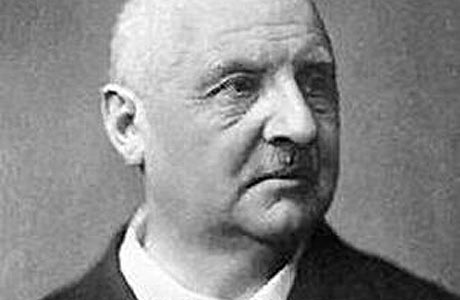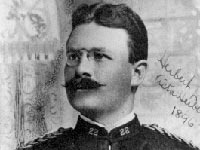2010 British Open Championships - Test piece review
31-Aug-2010Chris Davies looks in detail at this year's test piece and finds that Peter Graham has produced a corker...
 This year’s open test piece is a real corker.
This year’s open test piece is a real corker.
People often talk about test pieces being stylistically diverse (particularly last year’s open test-piece, 'Titan’s Progress’), but Peter Graham’s 'On the Shoulders of Giants' is simply in a league of its own.
The piece doesn’t just contain a variety of styles; it aims to incorporate a whole host of musical genres, from Germanic Romanticism to American jazz.
This is a real crowd-pleaser; a stunning, eclectic showpiece that really will separate the men from the boys.
Celebrating
Written for the Cory Band’s own-choice selection at the 2009 European Brass Band Championships, 'On the Shoulders of Giants', the piece is set in 3 movements, each celebrating a different aspect of brass-playing heritage.
Peter Graham notes in his score that ‘the art of brass playing embraces a range of diverse approaches and styles. Nowhere is this more apparent than in the musical melting pot of the USA’.
In this piece, Graham aims to highlight the fact that the great achievements in brass playing of today owe a great deal to the tenacity of the brass ‘giants’ of the past.
We can all relate to the idea of America as a serious front-runner in setting the standards of modern-day brass playing; whether the enormous sounds of the Boston Pops brass section in John Williams’s film scores or the dazzling virtuosity of Allen Vizzutti or Wynton Marsalis.
However, the references to the Negro spiritual Steal Away suggest that this piece has a much wider scope; it aims to pay tribute not just to brass greats, but also the traditions and composers who helped bring brass-playing to the fore (a pretty big ambition for a 15-minute test piece!).
On the Shoulders of Giants
“We are like dwarfs on the shoulders of giants, so that we can see more than they, and things at a greater distance, not by virtue of any sharpness of sight on our part, or any physical distinction, but because we are carried high and raised up by their giant size.” -Bernard of Chartres, French philosopher of the 12th century
Although Peter Graham attributes the phrase ‘on the shoulders of giants’ to a letter from Isaac Newton to Robert Hooke in 1676, the essence of the phrase has been around for a lot longer.
Bernard of Chartres (a French philosopher of the 12th century) and Didacus Stella (a theologian in the 16th century) are both quoted as using the phrase.
Poignant
Perhaps the most poignant example, however, dates from a 1651 document, where George Herbert (a Welsh poet, author and priest) states that ‘a dwarf on a giant's shoulders sees farther of the two’.
The whole idea of the concept is that modern developments, whether in science or brass playing, owe their existence to the pioneering work of our predecessors, whose devoted work put us where we are today.
In Graham’s piece, the giants on whose shoulders the ‘dwarfs’ stand include the brass section of the Chicago Symphony Orchestra (to which Adolph Herseth and Arnold Jacobs belonged), Miles Davis and Tommy Dorsey of the jazz movement, and the various world-renowned soloists of the Sousa Band.

Anton Bruckner - opening inspiration
Bruckner and Chicago
The first movement of Graham’s tour de force pays homage to the legends of the Chicago Symphony Orchestra brass section of the mid 20th-century.
Some of the greatest brass players of all time played with the orchestra during this time.
The great educator Arnold Jacobs served as their tuba player for an incredible 44 years, whereas the trumpet legend, Adolph Herseth, occupied the principal trumpet chair for 53 years (retiring at about 80!!).
The main material of the first movement (well, the 2 main sections flanking the vibrant ‘vivace’ in the middle) is taken from the finale of Bruckner’s '8th Symphony', known as the ‘Apocalyptic’.
Although the CSO were well-known for Bruckner, they were perhaps far more well-known as superb interpreters of Mahler (winning countless Grammy awards for recordings of Mahler symphonies).
The resolute inevitability of Graham’s bold opening 50 bars is almost identical to Bruckner’s, with the exception of the relentless triplets of the bass drum (which are simply quavers in the original).
Although Bruckner did not give the symphony the name ‘Apocalyptic’, he did intend the brass opening to evoke military music.
He also spoke of the ‘glorious brilliance’ of his final movement. Vivacious technical work comes next, before this big, bold opening comes back (this time accompanied by triplet fanfares in the cornets and euphoniums).
Miles Davis and Tommy Dorsey
‘Elegy’, Graham’s second movement, is an intensely contemplative sound-world, adopting a host of musical guises.
There’s something unsettling about the opening chord of this movement, built up gradually from the basses to the soprano over the opening 2 bars; it’s almost like being teleported to a different dimension.
Both E-flat basses offer strident, lyrical solos before a luscious duet between horn and cornet add another element of hiatus to the music through strangely beautiful harmonies.
We hear the theme of the finale here, as the soprano ‘sings’ a swooping solo up into the high register, closely followed by the horn.
Trombone and cornet solos follow, before we are taken through our first ‘musical portal’, into the world of Miles Davis.
The very first flugelhorn solo of the movement, which initially hints at the ‘Steal Away’ spiritual that comes later on, recalls a very specific period of Miles Davis’s career.
Between the late 1950s and the early 1960s he collaborated with Gil Evans, a jazz pianist and composer.
During this period he released some of his most unique albums, including 'Porgy and Bess' (a selection of arrangements from Gershwin’s opera) and 'Sketches of Spain' (featuring songs by the contemporary Spanish composer Joaquin Rodrigo, including one 'Concierto de Aranjuez').
On these albums Davis experimented with playing the flugelhorn for a few tracks.
The Sentimental Gentleman of Swing
The following trombone solo, also accompanied by ‘brushes’ in the snare drum, is the second portal Graham carries us through in the movement, evoking images of Tommy Dorsey.
Often known as the ‘sentimental gentleman of swing’, Dorsey’s smooth tone became famous in such hit tracks as 'Marie' and 'I’m Getting Sentimental over You'.
Graham’s trombone solo evokes the kind of bluesy feel to many of Dorsey’s tracks, before Davis and Dorsey are combined in a beautifully poignant flugel/trombone duet.
A magical moment (one of those bits that give you goose bumps when done well) leads the movement into a series of quotations from the first line of famous Negro spiritual ‘Steal Away’ by the horns.
The words for this mid-19th century spiritual are:
“Steal away, steal away, steal away to Jesus!
Steal away, steal away home, I hain't got long to stay here”
It’s a simple song, with a simple tune, yet its use here is an incredibly heartfelt and moving nod to the origins of the jazz movement in the ‘deep south’. The movement ends with the hushed whisper of a chord similar to the one that opened the movement, taking us back through that portal to home.
Clarke, Mantia, Pryor and Helmecke (who?!)
We hear a lot of repeated material in the opening bars of the third movement, but the bebop-like lines in the horns seem to bear reference to other jazz greats, including perhaps Dizzie Gillespie.
 We get this a few times, before the echoes of the Sousa band’s finest begin. Many of the most famous brass players of the early 20th century played in Sousa’s band, including Herbert Clarke (cornet), Simone Mantia (euphonium) and, of course, Arthur Pryor (trombone).
We get this a few times, before the echoes of the Sousa band’s finest begin. Many of the most famous brass players of the early 20th century played in Sousa’s band, including Herbert Clarke (cornet), Simone Mantia (euphonium) and, of course, Arthur Pryor (trombone).
The closing half of Graham’s finale (starting with a ‘misterioso’ marking) includes whispered, ghostly references to 'The Blue Bells of Scotland' (one of Pryor’s famous solos), 'Endearing Young Charms' (made famous by Simone Mantia), and 'The Debutante' (a famous Herbert Clarke solo - right).
The entire moto-perpetuo section that follows these quotations, with quiet scurrying in the basses and euphoniums, is based on the semiquaver patterns of Mantia’s final variation, but he is not the celebrated artist in this section.
Instead, Graham pays tribute to Sousa’s bass drum player, August Helmecke, who was allegedly the highest-paid ‘soloist’ in the band (although I’m not entirely sure what he would have to do with a celebration of brass greats!).
A vastly expanded version of the tune heard several times through the course of the piece leads the work to its closing statements: giant ‘footsteps’ (albeit marked ‘mf’!). There are some almost terrifying chords at the end here, and 2 giant thuds on the bass drum bring the work to an incredibly dramatic finish.
Tricky Bits?
It’s an unusual one, this.
On the one hand, there are some enormous sounds and textures, requiring some serious power from the tutti band.
You can’t help but notice, however, that a great deal of responsibility is placed on the shoulders (bad choice of phrase!) of soloists; namely euphonium, soprano, solo horn, solo trombone, flugel, and solo cornet.
There are a great many instances where tutti players are left out of the mix altogether (especially when it comes to quiet playing or really technical stuff). In general, second horn, as well as second and third cornets, have very few exposed, difficult things to pull off.
The second movement, for example, is all about exposed soloists, with gaping holes of white in the score (when, for example, the soprano or the solo horn go swooping up into the high register).
The end of the first movement has some similarly nerve-wracking textural moments: solo cornets and soprano in octaves, with euphoniums too, while only the baritones are added to the march-like choral of the opening.
These unisons and octaves are incredibly ‘splitable’, and it’s unusual that in such a climactic part of the piece repiano cornet down to second horn have nothing to do for some time. Will some bands try to overdo it in light of the fact that many of their colleagues are not playing with them at such a loud dynamic?
This is a piece that needs some serious strength on solo seats, as well as some serious control and nerve. Good luck to all euphonium players too – some of the solos in the final movement are insanely difficult (if you try to play it exactly as written that is…..), and clearly written with one particular man in mind.
A lot of the running semiquavers in the build-up of the last movement to its finale are also extremely ‘bluffable’.
The percussion is going to attract a lot of attention here (particularly the bass drum!), and it seems that Graham intended there to be a pulsating effect rather than a specific pattern of notes (although the outline is important).
How many bands will actually try and play exactly what’s written here? Effect plays a big part in the piece, but this should not be underestimated.
Even a slightly misbalanced chord can totally change the feel of certain sections.
Dealing with Genres
One of the hardest things for any band is going to be dealing with such different genres. The trombone and flugel solos/duet of the second movement probably shouldn’t be played ‘straight’.
Tommy Dorsey would never have played this solo without glissandos and bends, and I doubt that Miles Davis would approve of a flugel reading with clinical precision and a straight tone throughout.
Can brass band players loosen up enough to bring Davis and Dorsey into the room?
There are another few ‘moments’ that might catch bands out, including the return to the tempo primo at the end of the first movement (the transition of tempo is placed solely in the hands of the snare drum player), tuning and intonation in the second movement (especially where single players from perhaps 2 or 3 sections provide chordal support to solos), the many exposed unisons and octaves in the cornets and euphoniums (not just in the third movement, but also the second at G), and the correct realisation of the ‘listesso tempo’ in the finale.
This piece should provide all attendees with a great day of entertainment!
Chris Davies
Chris Davies is a postgraduate at the Royal Welsh College of Music and Drama, and is currently principal horn with the Tredegar Band.
He graduated from Oxford University in 2009 with a ‘first’ in music, is an Associate of Trinity College London, and a Licentiate of the Royal Schools of Music. Keenly interested in the science of music, Chris is involved in research aimed at furthering understanding of the physiology of brass playing, and is keenly interested in the cognitive neuroscience of music.
He is also the 2010 winner of the National Eisteddfod’s Blue Ribbon soloist competition.















